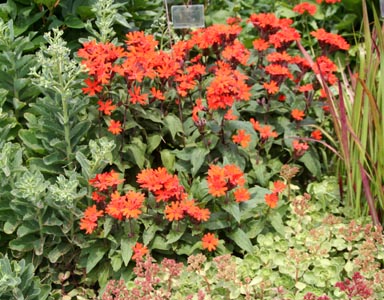
Most gardeners are familiar with rose campion, Lychnis coronaria, or Maltese cross, L. chacedonica, two of about 20 species in this genus in the pink family (Caryophyllaceae) from the northern temperate zone. Another garden-worthy Lynchnis is the cultivar ‘Vesuvius’ of the mixed-parentage L. ×arkwrightii. This plant is a complex hybrid between forms of L. ×haageana (itself from a cross between L. feulgens and L. coronaria v. sieboldii,) and L. chalcedonica. This whole group of plants was given the name Lychnis in the third century BC by Theophrastus, from the Greek lukhnis, meaning lamp, presumably because of the vivid color of the flowers.
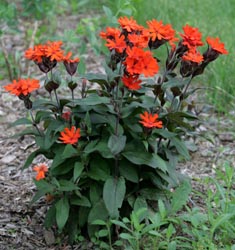
The genus is closely related to Silene, and recent studies indicate the two actually may be a single genus (in which case Silene is the prior name, and species in Lychnis would be renamed to Silene). This cultivar is perennial but may be short-lived under some conditions. The plant grows up to 18” tall, with erect stems and is hardy in zones 4-10 (although a zone 2 gardener reports having grown this plant for many years, so it may be hardier than generally accepted).
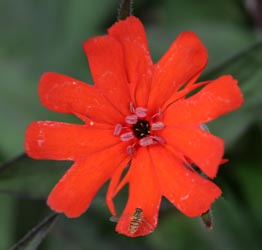
The flowers are a brilliant orange-red – like molten lava flowing from the volcano, Mt. Vesuvius. They are simple, with 5 deeply notched petals, but they are quite showy because they occur in heads (cymes) held well above the foliage, which maximizes their effect. The blossoms are large (1¼ -2” across), resembling a giant version of one of it parents L. chalcedonica. However, the flowers are clustered in small groups along the stems instead of in large rounded heads like Maltese cross. They bloom for a few weeks in early- to mid-summer. The flowers are followed by interesting seed pods that turn brown when mature.
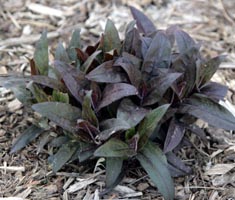
The foliage emerges a dark bronzy-maroon to purplish color, then becomes bronze-green with purplish stems that enhance the vivid flower color. The opposite pairs of ovate to lance-shaped leaves to 2.5” long are covered with short, stout hairs, giving them a somewhat rough or bristly feel.
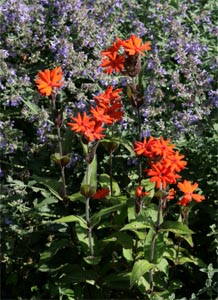
Use ‘Vesuvius’ in the front or middle of the border or in the rock garden. The loud orange flowers may be difficult to integrate into all gardens. The dark-colored foliage in early spring would be a good contrast with light-colored foliage, such as Heuchera ‘Peach Melba’ or H. ‘Creme Brulee’.
Grow in sun or part shade in ordinary garden soil. Plants can be pinched early in the season to induce branching for bushier plants. Deadhead frequently to encourage flowering and prevent self-seeding. This variety does best with even moisture throughout the growing season.
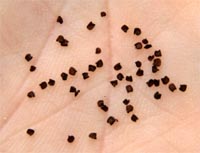
Being a named variety, ‘Vesuvius’ should be propagated by division in early spring or basal cuttings in late summer. It will self-seed in the garden, producing plants quite similar to the parent. Plants from seed sown indoors early may bloom the first year. To start indoors, surface sow. Do not cover the seeds, as they need light to germinate. Seedlings begin sprouting in 2-4 weeks. Transplant the seedlings when they are large enough to handle into 3” pots. Plant out in the garden in late spring or early summer.
Another similar cultivar, ‘Orange Gnome’ is a dwarf version of ‘Vesuvius’, growing only 8” tall.
– Susan Mahr, University of Wisconsin – Madison
Additional Information
- Lychnis x arkwrightii ‘Orange Zwerg’ ORANGE DWARF – on the Missouri Botanic Garden’s Kemper Center for Home Gardening website





 Aster, Symphyotrichum spp.
Aster, Symphyotrichum spp. Fascinating Fasciation
Fascinating Fasciation Alternatives to Lawn: Groundcovers
Alternatives to Lawn: Groundcovers Marigolds
Marigolds


